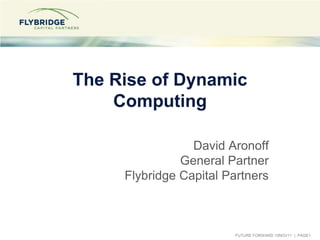D aronoff 9nov11 rise of dynamic computing
- 1. The Rise of Dynamic Computing David Aronoff General Partner Flybridge Capital Partners FUTURE FORWARD 10NOV11 | PAGE1
- 2. DESPITE ARCHITECTURAL CHANGES OVER TIME, APPLICATION DEVELOPERS HISTORICALLY HAD FEW CHOICES TO MAKE • Monolithic platforms force “one-size fits all” approach • Architectures tend to be bloated, brittle and energy intensive • In the immediate period after the emergence of internet application platforms, innovation and opportunities for new entrants were constrained 1960s Early 2000s FUTURE FORWARD 10NOV11 | PAGE2
- 3. RECENT MARKET FORCES HAVE BLOWN THIS MONOLITHIC, ONE-SIZE-FITS-ALL APPLICATION PLATFORM APART Cloud Open Computing Source Dynamic Scripting Virtualization Languages Exposed Data Flows & APIs FUTURE FORWARD 10NOV11 | PAGE3
- 4. INVESTMENT IMPLICATIONS Themes Implications 1. Developer-Driven Business ➟ Low cost, widespread adoption, wedge for Models growing additional sales 2. Legacy Applications Don’t ➟ Customers seek out alternatives as Translate Well traditional solutions no longer work given distributed topologies & ownership 3. “Big Data” Analytics of ➟ For 1st time can analyze global, real-time Exposed Data Flow & APIs behavior of users, applications & interactions 4. New Opportunities Emerge ➟ Disaggregation creates distinct problems and new applications that were unforeseen 5. Purpose-Built Foundation ➟ Innovator’s Dilemma for incumbents creating Technologies opportunities for big swings in core technology FUTURE FORWARD 10NOV11 | PAGE4
- 5. EXAMPLES Themes Example Companies 1. Developer-Driven Business Models 2. Legacy Applications Don’t Translate Well 3. “Big Data” Analytics of Exposed Data Flow & APIs 4. New Opportunities Emerge 5. Purpose-Built Foundation Technologies FUTURE FORWARD 10NOV11 | PAGE5
Editor's Notes
- #2: As you know, the two dominant sectors we target are enterprise IT and consumer infrastructure. Over the years, we have seen and invested in several inflection-point changes in these sectors - changes that have brought with them tremendous opportunities for new companies and innovation We're convinced we're in the midst of another such moment right now. It's more profound than simply jumping on the cloud-computing or mobile app bandwagons While these are important elements for certain, we see them as part of a larger shift we're calling "Dynamic Computing"
- #3: When we look at the evolution of computing, from the nexus with mainframes in the 1960s, through the Minicomputer, the PC revolution and into the advent of the commercial Internet in 1990’s, remarkably all these paradigms relied upon a relatively homogenous and monolithic architecture. This made sense at the start, because ubiquitous adoption of computing required establishment of a uniform standard platform.  It gave rise to the generation of behemoths that persist today, like Microsoft, Intel, Oracle, SAP, et al  But the strengths of this ecosystem, namely uniformity and backward compatibility have become their Achilles heels in the expanding world of the Internet – and these architectures have become bloated, expensive and energy hogs Combined with the intense industry consolidation that followed with the Internet bubble bursting at the turn of the century, innovation and new startup activity in the sector languished.
- #4: But more recently, the confluence of several core technology developments have exploded the traditional monolithic platform creating a fundamental revolution in how computing solutions are created and delivered  This is what we call Dynamic Computing, and it comprises the following components:Open Source – the movement that began with Linux in the 1990s was the initial catalyst, bringing low cost, high quality software – and most importantly – CHOICE Virtualization – originally conceived to get performance boosts from underutilized Intel chips, set the foundation for scalability and migration well beyond a single rack within one data center Cloud Computing – though the press has forgotten, what really began as ASPs, MSPs and SSPs, a decade ago, has lowered the cost of development and deployment infrastructure by orders of magnitude creating costs that scale with usage, which is critical to capital-constrained startups Dynamic Scripting Languages – such as python and Ruby – have made development faster, portable and scalable And Finally, public APIs have permitted two fundamental and ground-breaking changes:They allow applications to be dynamically assembled from best of breed providers, irrespective of geographic proximity.They provide the opportunity for unfettered access to previously unavailable data, the so-called “Big Data” firehoses. Add global affordable broadband, and the result is a set Dynamic Computing solutions that can be seamlessly split over great distances with no visible performance degradation.
- #5: Developer driven business models – really a basis





